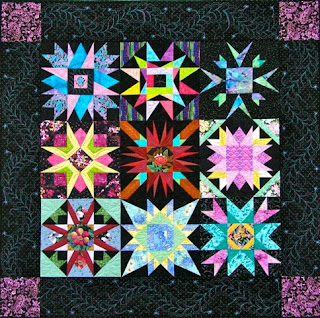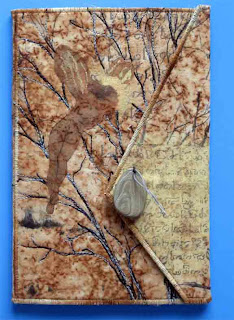Judith Baker Montano -- a colorful fabric artist in more ways than one -- shares her life, her loves, her home and most of all her art and techniques with us. Generous hardly describes how much she is willing to share in information, time, and techniques. Simpy looking at her creations, such as this block from her exquisite celebration of her home town not only inspires our own creativity but encourages us to also capture the essences and history of our surroundings in cloth.
Thank you Judith for joining us here at Subversive Stitchers: Women Armed with Needles! -- Dawn
The Alta Vida La Veta Project…..
by Judith Baker Montano
I live in a very small southern Colorado town with the population of 954! It is a historical mining town that over the years has become home to many writers, artists, musicians, aging hippies, cranky old ranchers and those forever outsiders, the summer people!
La Veta is nestled in the cleavage (valley) of the Wahatoya Mountains. This town has an addictive charm that draws people in. I speak from experience when I say…. If you come for a day you want to stay a week, if you come for a week you want to stay a month and if that ever happens…you are captured and La Veta becomes your home!!! (See Photo of La Veta, with the Wahatoya Mountains in the background.)
I have been returning to the La Veta area since 1968. My eccentric Aunt Ora, a retired professor, living in Trinidad, Colorado convinced my parents there was a fabulous journalism department at the Junior College, but that is a whole other story about a homesick Canadian ranch girl in the high sierra of southwest Colorado, working on the school newspaper and striking up lifelong friendships.
On the 1994 annual trip to Trinidad, I stopped in La Veta just to look around. I fell in love with an abandoned 1876 cottage. With the first royalty check from “The Art Of Silk Ribbon Embroidery,” I purchased the property and became the proud owner of four town lots, an uninhabitable cottage with a twenty-five year old trailer in the back yard!!
(See Photo 2)
Six months later, during a weekend stay to clean out the old trailer, I went to a local dance and met my husband Ernest Shealy!!
Ernest’s family had been returning to La Veta for over 35 years. I had been single for eleven years with two children in university and Ernest had lost his wife of 25 years to breast cancer. He came to visit friends and relatives and the rest is history.
La Veta has been very good to me!
For many years we lived between three locations but the novelty of that wore off in less than a year!! I had to have one home only! With my work I was travelling half the year and the shuffle between homes was overwhelming. Ernest and I both share a great love for southern Colorado so we chose La Veta as our permanent home. (Photo 3: Judith and Ernest on porch of their LaVeta home)
We were determined to save the old cottage (The Old Carver Place: Photo 4) and started the restoration in 1999. I wanted to honour the history of the property by restoring the yard and the buildings to their original beauty.
The original owners of the cottage were the Carver’s, a big ranching family in the La Veta area. One branch of the family moved to town and built the cottage, sheds and barn. The yard was given over to a large vegetable garden and 35 fruit trees plus several perennial flowerbeds. The big barn (torn down long ago) in the back yard housed horses, chickens, pigs and a dairy cow…
Mrs. Carver taught piano lessons in the front parlour and Mr. Carver did odd jobs about town. They were very limited in finances and the cottage never did receive a lot of attention. (Photo 5 of property in June, 2007)
In 2001 I met the Carver children, by then in their late eighties and they were able to show me the layout of the gardens and where the barn had been. They were in tears to think that someone wanted to save their childhood home.
Today we live in the cottage surrounded by huge perennial gardens, old apple trees, a garden shed/office and a beautiful studio/guesthouse. It is like paradise in a compound!!! We have saved the old Carver Place. (Photo 6: Judith's home, photo take July, 2009)
It is a joy to see the surprise in people’s face when they walk through the rose arbour. The cottage now sits proudly clad in yellow paint with white and teal trim. A rose purple band runs around just under the eaves. Australian fretwork decorates the porches and every window is topped with Australian awnings.
(Photo: Office Garden Shed in June)
(Photo: Studio in July 2009)
(Photo: Studio Porch in Sept. 2008)
Have you ever looked around and noticed that progress has changed the look and feel of your community? Old buildings have been torn down, some have been upgraded and new buildings have changed the look and feel of your surroundings. You suddenly realize that you’re homesick for the way things were.
(Photo: Old Adobe Shed) This happened to me several years ago when I was on my way to the hardware store. There was an old adobe shed that I liked to photograph but on this day it was gone, replaced by a nondescript plastic shed! It was such a shock that it galvanized me into action. So began the “Alta Vida La Veta” project.
The very next day I was with my camera to prowl up and down the alleys looking for old sheds and barns. Over the next two years I was able to photograph all the old houses, sheds and barns. With my photo collection complete I contacted several old timers to research the history of the buildings. That was a wonderful experience because I learned so much about my town and met so many interesting people.

I was not satisfied with just photographs and chose sixty for watercolour paintings.
Using Photoshop for colour correction, sizing photographs and creating traces, I painted the watercolours over a three-month period. You can find the whole process, from photography to watercolour painting in my new book “Fibreart Montage: Combining Quilting, Embroidery & Photography With Embellishments”

Each step is carefully depicted in diagrams, photographs and easy to understand instructions.
Once I finished the watercolours, I scanned them into my computer. Each painting was sized to 4” x 6”, 5” x 7”, and 8” x 10”. That way I could use them for greeting cards or prints. I could also use them for creating silk prints for crazy quilting, landscapes or embroidery.
I use silk fabric that comes in 8.5” x 11” sheets. The silk is adhered to removable paper and I use my bubble jet printer with archival inks for printing. I purchase Jacquard silk fabric sheets from Dick Blick Art Materials for the best price. You can also purchase organza and cotton fabric sheets for printing.
Knowing I could not save every old building in my beloved town I know I could create a record through my photographs and my watercolour paintings. I even created a book through Snapfish and gave it as gifts to our local Library, the La Veta Historical Society, friends and family.
(Photo: from book)

That same year I designed “Ornamentations”, a line of fabric for Robert Kaufman and they needed a sample quilt using the fabrics for the spring wholesale show. I decided to create a crazy quilt featuring the 4” x 6” La Veta watercolour silk prints because they look like postcards. Slowly the process turned into a large wall hanging that became even larger when I offered it as a gift to The La Veta Library. Upon seeing the blocks on the design board they wanted to feature it over the entrance fireplace!! So five more block later…..”Alta Vida La Veta” which means La Veta the high life was finished!

(Photo of another block in the Alta Vida La Veta quilt)
The crazy quilt and I went off to the May wholesale show and it was a huge success. Everyone wanted to know if the houses, barns and shed watercolours could be made into a new fabric line!!!
We introduced the new silk/cotton line “Radiance” with this collection and it is used throughout the Alta Vida La Veta crazy quilt. It is a magic fabric, 45% silk and 55% cotton so it has a fabulous sheen and a beautiful hand!! There are 63 solid colours and I got to choose them all. Everyone: the art quilters, crazy-quilters, fashionistos to the traditionalists love the Radiance line. For purchasing information go to your computer and google “Radiance, Robert Kaufman”.
I used my Montano Series of silk threads and ribbons by Treenway Silks for the embellishment/embroidery process. You can find this line on my website www.judithbakermontano.com by clicking on links.
Before presenting “Alta Vida La Veta” to the local library, I entered it in a local art show. The crazy quilt won best of show and that was such an honour to me because the award came from my community, my beloved La Veta, Colorado.
I hope my story gives you some ideas about commemorating your community or your home. Perhaps you want to create a project around a childhood home or a vacation spot. Look through my new book and all the chapters. It encourages you to mix mediums to create original fibreart projects.
Judith Baker Montano
www.judithbakermontano.com
 When people do not learn the proper way to paper piece, they do run into stressful situations like not having cut the correct size fabric piece or they place it incorrectly. With just a bit of time invested to learn how to paper piece, you can count on success every time! When I teach a class, I can have students who have never paper-pieced achieve the same success as those who have because it is a method.
When people do not learn the proper way to paper piece, they do run into stressful situations like not having cut the correct size fabric piece or they place it incorrectly. With just a bit of time invested to learn how to paper piece, you can count on success every time! When I teach a class, I can have students who have never paper-pieced achieve the same success as those who have because it is a method.




























